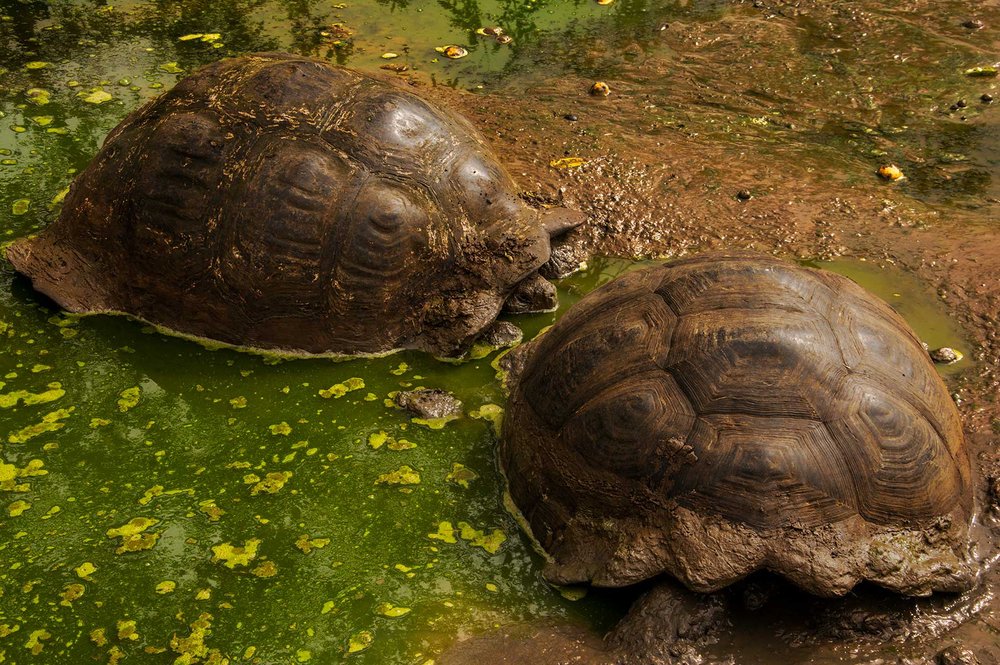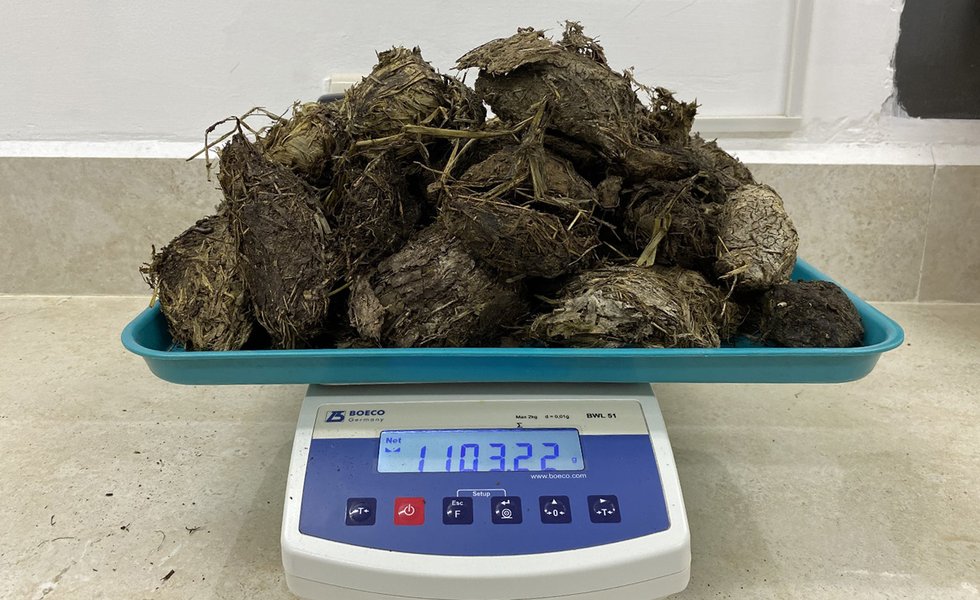Galápagos, 8 November 2023 - A new study published in the journal Environmental Pollution found that giant tortoises on Santa Cruz Island, Galapagos, are ingesting plastic waste in and near urban areas. A collaborative study involving researchers from the Charles Darwin Foundation (CDF), the Pontificia Universidad Católica del Ecuador (PUCE), Saint Louis Zoo in the US, the Universidad Complutense de Madrid in Spain, and the James Cook University in Australia, evaluated the ingestion of garbage by the Western Santa Cruz Giant Tortoises (Chelonoidis porteri), which are classified as "critically endangered" by the International Union for Conservation of Nature (IUCN).

Karina Ramón, a passionate Galapagos native, conducted this research as part of her bachelor's thesis. She and the research team collected and analyzed over 5,500 tortoise fecal samples from areas where giant tortoises overlap with human activities, and over 1,000 samples from protected National Park zones. The results of their analysis showed that giant tortoises more frequently consumed garbage produced by human activity in areas occupied by humans, such as the western part of Santa Cruz Island, while, in protected areas, exposure to this waste was almost nil:
The human population of the Galapagos Islands has increased dramatically in recent decades. This trend is related to the increase in tourism, accelerating anthropogenic pressures on the archipelago’s natural systems.
“Plastics persist in the environment much longer than the usefulness of the product and we believe that tortoises mistake such solid waste for food. Giant tortoises can take up to 28 days to digest what they eat, so we are concerned about the impact that ingestion of non-organic waste may have, as this could trigger numerous negative effects on the animals' health, including injuries, intestinal obstructions and even hormonal changes due to the chemical components found in these materials,” says Karina Ramón, lead author of this study.
This is the first comprehensive study that records and quantifies the ingestion of plastics in a terrestrial species as iconic as the Galapagos giant tortoise.
“This study demonstrates that protected areas in the National Park are essential for the well-being of endemic species, where almost no plastic was found. However, it also highlights an environmental problem that persists in populated areas of the archipelago that could not only affect populations of critically endangered species, but also the health of people who visit and live in these fragile ecosystems,” adds Dr. Santiago Ron, co-author and professor at PUCE.
“In the Galapagos Islands, conservation actions are one step ahead in terms of plastic use. In 2015, regulations were issued to ban the sale and use of numerous single-use plastic items, including straws and plastic bags, an action that has not yet been implemented on the continent. However, the amount of disposable plastic that is found in the Galapagos Islands remains very high. It is key that local authorities strengthen existing laws and regulations and implement strict control measures to limit the use of plastics in Galapagos, and prevent them from ending up contaminating terrestrial and marine ecosystems,” notes Dr. Ainoa Nieto Claudín, senior co-author, wildlife veterinarian at the Saint Louis Zoo, and CDF collaborating scientist.
The archipelago’s Environmental Authority has implemented various actions over the years to reduce the impact of human activities on giant tortoises. Since 2017, the campaign "More Life, Less Trash" has been implemented to promote the use of reusable water flasks in schools in the province. The Galapagos National Park Directorate led the Ministerial Agreement 097, which prohibits the use of single-use plastics in all educational establishments of Ecuador. In 2022, the “Young Protectors of Giant Tortoises” program was launched. This program engages youth from the community to monitor and relocate reptiles found in or near urban areas to safer places, as well as to collect garbage found in areas frequently visited by these species.
“The Galapagos Islands offer a unique opportunity for humanity to demonstrate its abilityto live in harmony with nature. Considerable efforts have been made to raise environmental consciousness among the local population, including initiatives spearheaded by the Charles Darwin Foundation and its environmental education program. Bolstering such environmental education campaigns in the Galapagos could be instrumental in further raising awareness among residents and visitors about the imperative of preventing plastic pollution, while also encouraging more sustainable behaviors towards nature,” adds Dr. Rakan Zahawi, Executive Director of the Charles Darwin Foundation.

The Charles Darwin Foundation, through its Galapagos Tortoise Movement Ecology Program, studies the movement patterns of Galapagos giant tortoises, as well as the social, ecological, and health factors that affect their conservation. This program is a multi-institutional collaboration between CDF, the Galapagos National Park Directorate, the Saint Louis Zoo, Houston Zoo, and Galapagos Conservation Trust in the UK.
To read the full study in the journal Environmental Pollution, please visit:
https://www.sciencedirect.com/science/article/abs/pii/S0269749123017827?via%3Dihub
Media Contacts:
María José Utreras, Charles Darwin Foundation
mariajose.utreras@fcdarwin.org.ec | +593 (0)98 408 7697
Ambre Tanty-Lamothe, Charles Darwin Foundation
ambre.tanty@fcdarwin.org.ec | +593 96 787 1557
About the Charles Darwin Foundation
The Charles Darwin Foundation for the Galapagos Islands is an international nonprofit that has been present in the Galapagos since 1959, thanks to an agreement with the Government of Ecuador. Its mission is to tackle the greatest threats and challenges to Galapagos through scientific research and conservation action, in order to safeguard one of the world’s most important natural treasures. At present, CDF manages over 25 research and conservation projects and is the custodian of more than 135,000 specimens within its Natural History Collections.





